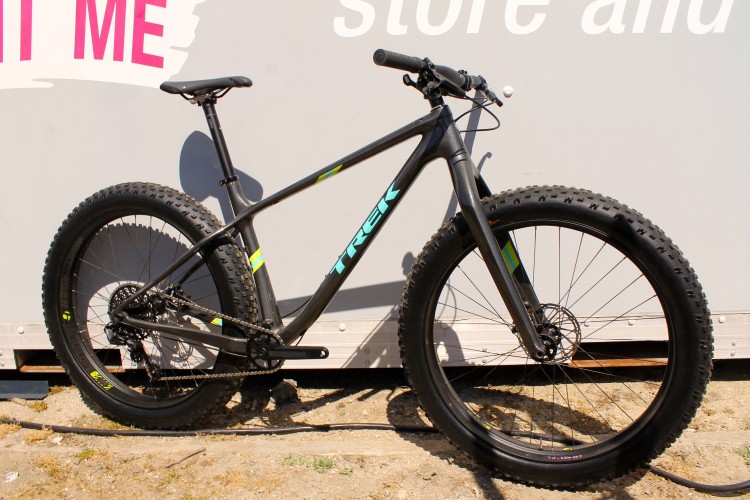If you’ve been shopping for a fat bike, hopefully you’ve had the opportunity to read maddslacker’s excellent series of articles reviewing different models at varying price-points. If not, here are the links:
Price will almost certainly be most riders’ ultimate purchase-limiting variable, but within certain budget ranges there are a lot of choice. Frame materials and quality components drive the prices for almost every bike.
Frame material isn’t just about cost. Each frame material, which vary from manufacturer to manufacturer, has subtle nuances that different riders prefer. Here’s a short summary to make sense of it all.
Steel
“Steel is real,” as many riders who prefer steel put it. Steel was once considered “old school,” a craft industry, until larger names like Surly and Niner heavily advertised its long-forgotten properties.

Steel is heavy, but its strength lies in, well… its strength. Steel is strong, so smaller tubes can and are used to build frames, which is a look many riders prefer because it accentuates the fat tires well. More importantly, using smaller tubes allows the frame to flex, much more so than aluminum can. This improves rider comfort, particularly on a fully rigid frame.
Steel rusts, which may leave you scratching your head as to why anyone would use it on a bike that is subjected to snow and ice, but modern steel frames are treated and painted, and resist corrosion rather well. Surly uses patented 4130 CroMoly steel, an industry standard, which is flexy and has a unique ride quality. You honestly have to ride one to understand. And although steel is heavier than most other materials, bikes can still be built rather light when using higher-end components.
Aluminum
Quickly becoming the new industry standard, aluminum is praised for its light weight and resistance to nature’s plan to destroy your bike. The fat bike market exploded this year, with big names like Specialized and Trek producing bikes in their proprietary aluminum offerings. 9:zero:7 has been using aluminum for quite some time, but fat bike veteran company Salsa, who had been making the aluminum Mukluk for years, released the 2013 Beargrease last year using 6000-series EV6 Extrolite found on other frames. At only 5.2 lbs, this frame/bike was lauded for its innovative strength-to-weight ratio, and the bikes sold out fast nationwide. Some even credit this particular model, with it’s creative use of EV6, for catalyzing the fat bike “movement” the market has experienced this season.

Undoubtedly, most riders who are shopping for a fatty will purchase an aluminum frame because of the sheer number of companies using it now–and it is a great choice for any bike. However, aluminum can feel more rigid than steel, due in part to the use of larger tube diameters, making the bike stiffer overall.
Carbon
Aaaah, carbon. The very word can make the heart of a cyclist skip a beat or two. We all know that carbon has been widely used in the mountain bike industry for years, and for some riders, it is the only material they choose to use.

Many did not expect carbon to be used in the fat bike industry for years to come, but in a surprise move Salsa discontinued the widely-popular aluminum Beargrease from last season, and released a carbon-only version for the 2013/2014 fat biking season. Even more surprising, a small Colorado-based company named Borealis came out of the blue to announce its first fat bike, the carbon Yampa. Borealis deftly released the Yampa before the Beargrease, stealing a little of its thunder. Also this season, 9:zero:7 produced the beautiful carbon Whiteout, and Fatback is set to launch the curvy carbon Corvus soon.
So, does carbon provide any advantage to a bike you are probably just going to pedal on cold, soft, crunchy snow? Absolutely. Most of us know that carbon is light… much lighter than almost any other material given its strength-to-weight ratio. Carbon is also rigid, and yet it’s flexy like steel (yet subtly different). Carbon is quiet when you are pedaling (paired with a SRAM XX1 drivetrain, it’s really quiet), and unlike any other mainstream frame material, it’s handily not freezing-cold to the touch. Best of all, carbon absorbs impact very well… which is a plus on a fully-rigid bike with squishy fat tires.
One thing to keep in mind when you are shopping: these properties are great for riding in soft snow, but they are even better when you take your fat bike on your favorite piece of single track in the summer. There’s just something double-awesome about riding a carbon fatty on a technical trail and keeping up with–and sometimes surpassing–your friends. 🙂
Titanium
Moots. Black Sheep. Carver. Lynskey. These are some of the guys making custom titanium fat bike frames. Like carbon, they can be quite expensive, but you get what you pay for. As maddslacker saliently pointed out, “if you have to ask…”
While I’ve owned several titanium mountain bikes, I personally have never ridden a titanium fat bike, but I think the frame qualities translate over. I generally think of ti as having all of the beneficial properties of steel, while being much, much lighter.

Lynskey has somewhat mass-produced the relatively-affordable Stratus (an excellent bike), but most of the other ti frame builders only make bikes to order. Most are also completely custom (except Moots), which is another benefit of titanium.
I was really impressed with the very creative full-suspension Black Sheep fatty I saw at the 2013 North American Handmade Bicycle Show, and when I talked to them and priced it out in the $10-12,000 range, I realized that risking a divorce was not worth having this particular custom model.
Bottom line: ti is awesome if you can afford it, and even better if you really need a custom fat bike.
Bamboo
Regarding bamboo, someone once commented to me that they didn’t understand why a bike, which is supposed to be ridden only in the snow, was being built out of a material only found in the jungle. My response to that was, “show me where to find a carbon or titanium tree.” Crazy logic, I know, but the fact is building bikes out of bamboo seems a little crazy to a lot of people.
I’ll admit, I thought bamboo as a fat bike frame material was a little iffy until I started looking into it. Boo Bicylces now makes the Alu Booyah, a bamboo/aluminum hybrid frame construction.

Above all else, bamboo is an art form. It’s unique, eccentric, and definitely a conversation starter. However, bamboo is strong stuff. Highly-praised publications that have reviewed bamboo-framed bikes say that it actually absorbs and dampens vibration better than carbon. What? Maybe we’ll see a Tour de France team with a bamboo fleet soon.
That is unlikely, but nevertheless, after researching this material I have to say I am intrigued and would love to try (read: own) one. My recommendation is that if you are in the market for a custom fat bike, and you have a little extra disposable income, this type of bike should be on your short list!
Conclusion
There are a lot of choices in frame material in an evolving and emerging fat bike market, and choice is a good thing. Aside from frame material, frame geometry and design (braze-ons, mounts, etc….) should also be something you consider when purchasing a fat bike. Demo as many as you can, and happy hunting!
Your Turn: Do you have any personal experiences, positive or negative, with a particular fat bike frame or material?










1 Comments
Jan 16, 2014